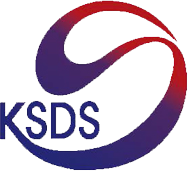1. 연구의 배경 및 목적
2. 이론적 배경
2.1 ISO 경영 시스템
2.2 ISO 19011(Guidelines For Auditing Management Systems)
2.3 역량(Competency)과 역량모델(Competency Model) 이론
3. 연구방법
3.1 연구대상자 선정 및 연구 방법
3.2 분석 방법
4. 연구결과
4.1 연구대상자의 일반적인 특성
4.2 문항 신뢰도 분석
4.3 심사역량에 대한 중요도-보유도 평균차이 및 유효성 분석
4.4 심사역량 영역 및 요소별 중요도와 요구도 분석 및 검증
5. 결 론
1. 연구의 배경 및 목적
ISO(International Organization for Standardization)는 국제 표준화 기구를 말하며, 지적활동이나 과학 경제 분야에서 전 세계 상호간의 협력을 위해 설립된 단체이다. ISO 시스템 규격은 국제표준화기구에서 제정한 분야별 시스템 인증을 위한 규격으로서 주로 품질, 환경, 안전보건, 식품안전, 정보보안, 에너지 분야 등으로 분류된다. 최근 기업의 사회적 책임이 점차 커져가고 있음에 따라, 고객기업의 경제적 번영과 환경보호, 사회적 정의를 달성하기 위하여, 많은 기업들은 ISO 인증에 가치를 두고 있다. ISO 인증은 모든 기업들이 반드시 받아야 하는 강제적인 인증은 아니다. 그렇지만, 원활한 무역을 위한 국제사회의 공조가 확대되고, 글로벌 시장에서 우위확보를 위해 표준에 대한 선점 경쟁이 치열해지면서 국제표준의 중요성도 높아지고 있는 추세이다. 특히, 세계무역기구(WTO) TBT1)(Agreement on Technical Barriers to Trade)는 각국이 국가표준을 제·개정하는 경우 국제무역에 있어서 장벽이 되지 않도록 국제표준을 의무적으로 채택하도록 규정하고 있다. 이런 이유 때문에 국제표준은 국제사회에서 구속력은 없지만, 대부분의 국가가 수용하고 있어서 사실상 의무 규정화되고 있는 실정이어서 기업의 입장에서는 ISO 인증이 사업의 성패에 직접 작용하는 핵심요인 중의 하나이다. 그러므로 기업의 ISO 인증에 대한 전 과정을 주도하고, ISO 경영시스템의 적합성을 평가하는 ISO 심사원의 역량이 무엇보다 중요하다. 그런데 ISO 심사원의 양성 및 보수 교육과정을 살펴보면, 심사원이 현재 보유하고 있는 수준과 비교하여, 우선적으로 필요한 심사역량을 향상시키기 위한 체계화 된 교육과정을 찾아보기가 어렵고, 과거와 동일한 교육과정을 여전히 고수하고 있는 실정이다. 이에, 본 연구에서는 ISO 심사원이 갖추어야 할 개인적 특성과 함께 전문지식과 전문기술의 중요 심사역량요소들에 대한 중요도와 보유도를 분석을 통해서, ISO 심사원에게 우선적으로 필요한 최우선 역량요소와 차기역량요소를 도출하였다. 이 결과를 토대로 심사원들의 교육과정을 개선하여 심사원들의역량 강화에 기여할 수 있고, 나아가 기업의 품질, 환경, 안전보건, 사업연속성 등의 ISO 경영시스템에 대한 강화에 도움을 줄 수 있을 것으로 기대한다.
1) TBT협정이란 나라별 표준이 범세계적 시장형성에 장애가 되므로 이를 제거해 국제표준을 설정하는 것을 일컫는다.
2. 이론적 배경
2.1 ISO 경영 시스템
ISO 경영 시스템 인증은 특정 조직의 품질, 환경, 안전보건 등 경영시스템이 국제표준화 기구에서 마련한 국제규격에 적합하게 구축되어 있음을 증명하는 제도로 ISO 9001(품질경영시스템), ISO 14001(환경경영시스템), ISO 45001(안전보건경영 시스템)의 비교 및 요구사항은 Table 1과 같다.
Table 1.
Comparison of ISO Management System for ISO 9001, ISO 14001 & ISO 45001
|
Division
|
ISO 9001
|
ISO 14001
|
ISO 45001
|
|
Citation criteria
|
BS 5750 (TC176)
|
BS 7700 (TC207)
|
BS 8800, ILO-OSH
|
|
Standard
|
QMS
|
EMS
|
OH & SMS
|
|
Goal
|
Customer Satisfaction
|
Workers & Interested parties
Satisfaction
(Mainly External)
|
Workers & Interested parties
Satisfaction
(Mainly Internal)
|
|
Models
|
PDCA Cycle
|
PDCA Cycle
|
PDCA Cycle
|
|
Subject
|
Product or Service
|
Product or Waste service
|
Work Condition
& Human behavior
|
|
Key Points
|
Customer Requirement
Regulatory Requirement
|
Environmental Legal
& Aspects/Impact
|
Occupational Health & Safety Legal
&Hazard/Risk
|
General Common
Requirement
|
* HLS (High Level Structure)
4.0 Context of organization, 5.0 Leadership & worker participation, 6.0 Planning, 7.0 Support, 8.0 Operation,
9.0 Performance evaluation, 10.0 Improvement
|
2.2 ISO 19011(Guidelines For Auditing Management Systems)
ISO 19011(Guidelines for auditing management systems)은 조직의 품질방침, 안전보건 방침, 환경방침 등의 효과적인 실행을 모니터링하고 검증하는 경영도구로서, 심사원의 평가 및 적격성뿐만 아니라 심사 프로그램 관리 및 관리 시스템에 대한 심사실시의 원칙을 포함한 심사 관리 시스템에 대한 지침과 심사 프로세스에 관련된 개인의 역량평가에 대한 지침을 제공한다. 경영시스템 심사에 대한 각 단계별 지침은 Table 2와 같다. 본 연구에서는 Table 1과 Table 2를 근거로 하여, ISO 인증 심사원이 갖추어야 할 전문지식과 직무기술 부문에 대한 심사역량을 진단하기 위해, 전문지식 부문에서는 일반지식, 전문지식, 응용지식으로 분류하여 총 14개의 진단척도를 개발하였고, 직무기술 부문에 있어서는 기초 실무기술과 응용실무기술로 분류하여 13개의 진단척도를 개발하였다.
Table 2.
Guidelines on every step of auditing a management system or audit program
|
Step
|
Division
|
Guidelines
|
|
1
|
Defining Program Objectives
|
- Ensuring you understand the specific objectives you hope to achieve
- Making audit arrangements
- Assigning roles and responsibilities
- Defining number, scope, location, and duration of audits
- Determining criteria and specific checklists
- Establishing review procedures
|
|
2
|
Completing the audits needed
|
- Planning and reviewing internal documents
- Collecting and verifying audit evidence
- Generating findings and preparing reports
- Communicating findings
|
|
3
|
Review the results and process
|
- Assessing results and trends
- Conforming with audit program procedures
- Evolving needs and expectations of interested parties
- Analyzing audit program records
- Examining effectiveness of the measures to address risks
- Ensuring confidentiality and information security
|
2.3 역량(Competency)과 역량모델(Competency Model) 이론
오늘 날처럼 치열한 경쟁 속의 세계화된 조직 환경에서 조직경쟁력을 유지하기 위해서는 최첨단의 기술력과 조직내부의 기술이나 단순한 기능을 뛰어 넘는 조직 구성원의 역량에서 좌우되는데, 이러한 차원에서 역량(Competency)이 중요시고 있다. 21세기의 세계화된 경영환경 하에서 조직의 전략적 경영목표의 달성 여부는 핵심인재의 발굴과 육성에 달려 있다고 해도 과언이 아니다. 최근 선진기업에서는 탁월한 업무성과를 달성하는 데 필요한 개인의 역량을 파악하고 그 결과를 인적자원관리에 활용하기 위해 노력을 아끼지 않고 있다. 즉, 역량 모델은 인적자원관리의 주요 영역인 선발, 보상, 승진, 승계, 교육 훈련과 연계될 수 있다(Abosch and Reidy, 1996).
2.3.1 Boyatzis 역량모델 이론
보야티스(Boyatzis, 1982)는 역량을 이해하기 위해 3가지의 중요한 관점인 자기상, 사회적 역할, 기술을 기준으로, 역량은 어떤 개인이 어떤 역할을 수행함에 있어 성공적인 결과를 가져 오는 그 개인이 가지고 있는 잠재적인 특성으로 정의하였고, 역량의 6가지 역량 군으로 Table 3에서와 같이 역량모델을 주장하였다(Boyatzis, 1982).
Table 3.
Boyatzis’ Competency Theory
|
Global and Action Management Cluster
|
Directing Subordinates Cluster
|
- Efficiency orientation
- Productivity
- Diagnostic use of concepts
- Concern with impact
|
- Developing others
- Use of unilateral power
- Spontaneity
|
|
Leadership Cluster
|
Focus on Other Cluster
|
- Self-confidence
- Use of oral presentations
- Logical thought
- Conceptualization
|
- Self-control
- Perceptual objectivity
- Stamina and adaptability
- Concern with close relationships
|
|
Human Resource Cluster
|
Specialized Knowledge
|
- Use of socialized power
- Positive regard
- Managing group processes
- Accurate self-assessment)
|
- Memory
- Specialized knowledge
|
2.3.2 Spencer 역량모델 이론
스팬서(Spencer & Spencer, 1993)는 역량(Competency)은 개인의 내적 특성으로서 다양한 상황에서도 비교적 장시간 지속되는 행동 및 사고방식을 의미하며, 대표적인 내적 특성을 동기(Motives), 특성(Traits), 자기개념(Self-concept), 지식(Knowledge), 기술(Skill) 이상 5가지 개인의 내적 특성 중에서 지식과 기술은 비교적 가시적이며 표면적인 특징을 가지는 반면, 동기, 특성, 자기개념은 개인의 내면에 위치하여 파악하기 어려운 부분으로 즉, 지식과 기술은 교육훈련을 통해 어느 정도 개발 육성이 가능하나, 동기와 특성은 인간 내면의 밑바닥에 자리를 잡고 있기 때문에 육성과 개발을 통해 바꾸기는 쉽지 않다고 Table 4와 같이 주장하였다(Spencer and Spencer, 1993).
Table 3의 Boyatzis 역량모델 이론과 Table 4의 Spencer 역량모델 이론을 근거로 하여, ISO 인증심사원이 갖추어야 할 개인특성에 대한 역량을 진단하기 위해, 개인특성 부문을 리더쉽, 영향력(타인에 대한 관심), 인지, 기타 4가지로 분류하여 총 23개의 진단척도를 개발하였다.
Table 4.
Spencer & Spencer’ Competency Theory
|
Achievement and Action
|
Helping and Human Services
|
- Achievement orientation
- Concern for order, Quality and Accuracy
- Initiative
- Information-Seeking
|
- Interpersonal Understanding
- Customer Service Orientation)
|
|
The Impact and Influence Clusters
|
Managerial
|
- Impact and Influence
- Organizational Awareness
- Relationship Building
|
- Developing Other
- Directiveness
- Teamwork and Cooperation
- Team Ledership
|
|
Cognition
|
Personal Effectiveness
|
- Analytical Thinking
- Conceptual Thinking
- Technical/Professional/Managerial Expertise)
|
- Self-Control
- Self-Confidence
- Flexibility
- Organizational Commitment
|
3. 연구방법
3.1 연구대상자 선정 및 연구 방법
본 연구는 현재 활동 중인 ISO 심사원 50명을 대상으로, 2019년 12월부터 2020년 02월까지 약 3개월에 걸쳐 설문조사를 실시하였다. 회수된 50부의 설문지 중에서 응답이 불성실한 1부의 설문지를 제외한 최종 49개의 설문지 분석은 심사원의 역량을 진단하고, 가능성을 모색하기 위한 탐색적인 연구라고 할 수 있다. 본 설문지는 응답자의 일반적인 특성을 나타내는 문항으로 구성된 1부와 관련 선행연구, 참고문헌을 통해 심사원이 필요한 심사 역량을 전문지식, 전문기술, 개인 특성 영역으로 구분하여 총 50개의 역량요소로 설문을 구성하였다. 각 문항은 중요도(필요수준) 부문에서 “매우 중요하다”, “중요하다”, “보통이다”, “중요하지 않다”, “매우 중요하지 않다”와 보유도(현재수준) 부문에서 “매우만족”, “만족”, “보통”, “부족”, “매우 부족”이라는 5점 Likert 척도로 구성하였다.
3.2 분석 방법
설문조사로 수집된 자료는 Window10, SPSS 25.0과 Excel 2016을 이용하여, 응답자의 일반적인 특성을 빈도와 백분율로 분석하였고, 대응표본 t검정을 통해, 각 역량영역별로 중요도와 보유도 수준의 평균값 차이가 유의한지 통계적으로 확인하였다. 이 분석결과를 바탕으로, Borich 계수 산출을 통해 각 역량요소별로, 우선순위를 도출하였고, Locus for Focus 모델을 활용하여, 역량영역별로 2개의 축으로 구성된 좌표평면에 도출된 결과를 분류하였다. 아래는 Borich 계수 산출 공식이며, Locus for Focus 모델과 그 분석절차는 Fig. 1과 Fig. 2와 같다.
Borich 계수 =
- N : 전체 사례 수
- RCL(Required Competence Level) : ISO 심사원에게 요구되는 심사 역량 수준(중요도 수준)
- PCL(Present Competence Level) : ISO 심사원이 현재 보유하고 있는 심사 역량 수준(보유도 수준)
- : 요구되는 역량 수준의 평균값(중요도 수준의 평균값)
Mink의 Locus for Focus Model은 중요도 수준을 가로축으로 하고, 중요도 수준과 보유도 수준의 차이 를 세로축으로 하여, 설문 결과로 도출된 각각의 평균값을 기준으로 2개의 축으로 구성하여, 총 4개의 분면으로 구분한 후, 각 역량 구성요소들에 대한 우선순위를 시각적으로 제시하고, Borich 계수를 활용 한 최우선 순위 결정을 구분하여 검증할 수 있는 모델로, 중요도가 높고, 두 수준의 차가 평균값보다 높은 영역인 1분면(HH)은 가장 집중관리가 필요한 우선순위 영역이고, 두 수준의 차가 평균값보다 낮 고, 중요도 역시 평균값보다 낮은 3분면(LL)은 우선순위가 가장 낮은 영역으로 볼 수 있다(Cho, 2009).
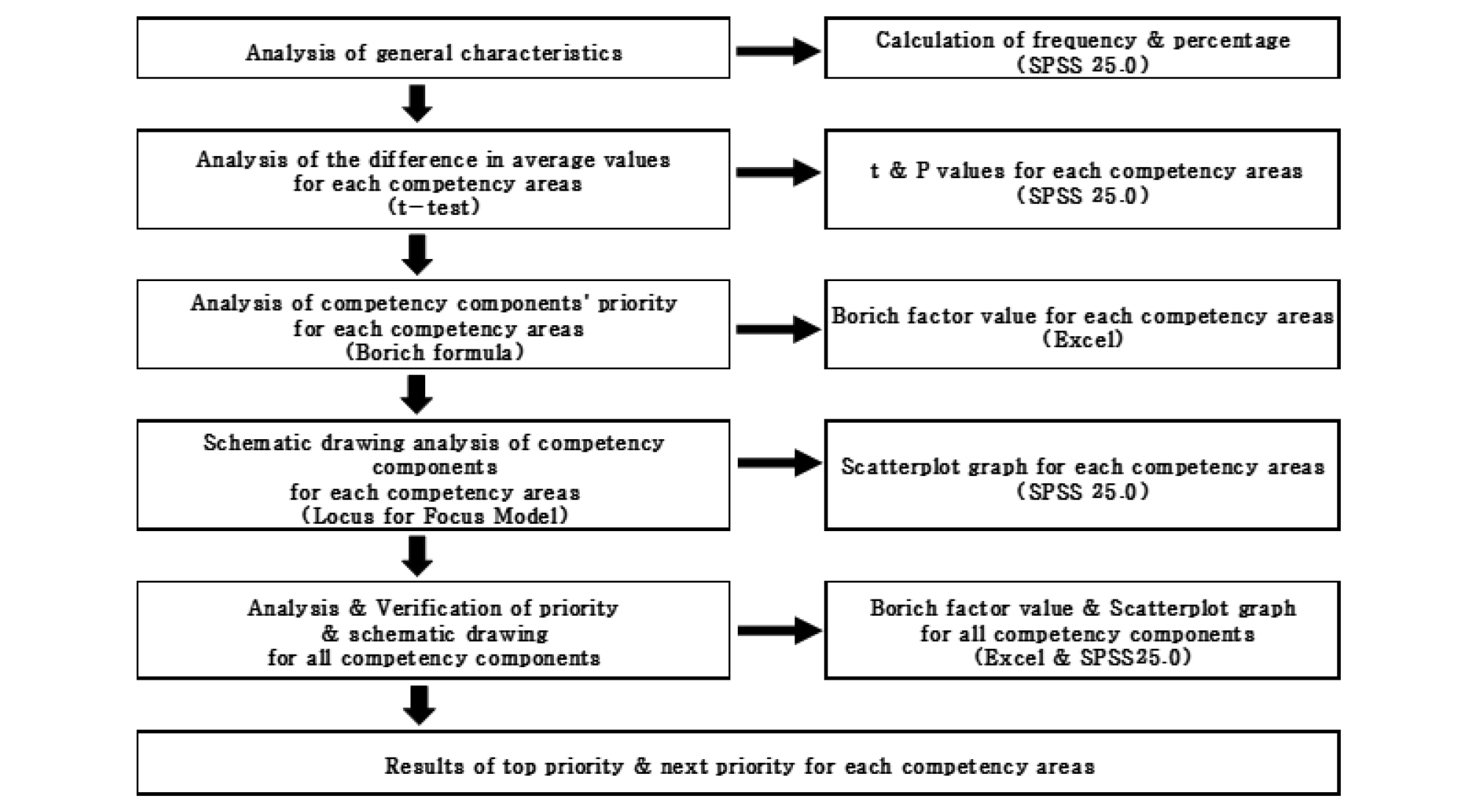
Fig. 2.
Analysis Procedure of Auditing Competency
4. 연구결과
4.1 연구대상자의 일반적인 특성
Table 5에서와 같이, 연구 대상자는 남자 심사원이 44명(89.8%), 여자 심사원이 5명(10.2%)으로 총 49명이었고, 연령대는 40세에서 59세 사이가 36명(73.5%)으로 가장 많았으며, 최종학력과 전공분야에 있어서는 석·박사를 포함한 학사 이상 47명(95.9%), 공학계열 35명(71.4%)이었다. 심사경력과 심사원 자격에서는 5년 미만이 24명(49.0%), 5년 이상 15년 미만이 12명(24.5%), 15년 이상이 13명(26.5%)으로 분포하였고, 2개 이상 심사원 자격을 소유하고 있는 심사원이 32명(65.3%)이었다.
Table 5.
General Characteristics (N=49)
|
Category
|
N
|
N (%)
|
|
Gender
|
Male
|
44
|
89.8
|
|
Female
|
5
|
10.2
|
|
Sum
|
49
|
100.0
|
|
Age(yr)
|
30-39
|
6
|
12.2
|
|
40-49
|
17
|
34.7
|
|
50-59
|
19
|
38.8
|
|
More 60
|
7
|
14.3
|
|
Sum
|
49
|
100.0
|
|
Major
|
Engineering
|
35
|
71.4
|
|
Humanities
|
4
|
8.2
|
|
Current account
|
5
|
10.2
|
|
Natural Science
|
5
|
10.2
|
|
Sum
|
49
|
100.0
|
|
Highest level of education
|
College's degree
|
2
|
4.1
|
|
Bachelor's degree
|
26
|
53.1
|
|
Master's degree
|
16
|
32.7
|
|
Doctoral degree
|
5
|
10.2
|
|
Sum
|
49
|
100.0
|
|
ISO Auditor's career (yr)
|
Less 5
|
24
|
49.0
|
|
5-14
|
12
|
24.5
|
|
More 15
|
13
|
26.5
|
|
Sum
|
49
|
100.0
|
|
ISO Certification
|
ISO 9001 (QMS)
|
7
|
14.3
|
|
ISO 45001 (OHSMS) or 14001 (EMS)
|
10
|
20.4
|
|
2 or more
|
32
|
65.3
|
|
Sum
|
49
|
100.0
|
4.2 문항 신뢰도 분석
본 설문지의 3개 역량영역에서 총 50개의 설문 문항과 관련하여, 문항의 내적 일관성은 3개의 역량영역에 대해서 ISO 심사원이 얼마나 일관되게 설문에 응답하였는가를 Cronbach’𝛂 계수를 통해 검증하였고, 분석결과, Cronbach’𝛂 계수가 0.9 이상으로 높은 신뢰도가 있음을 확인할 수 있었다.
Table 6.
Cronbach’ alpha of each competency cluster
|
Competency cluster (Question)
|
Specialized Knowledge (1-14)
|
Job Skill (15-27)
|
Personal Characteristics (28-50)
|
|
Cronbach'𝛂
|
0.942
|
0.910
|
0.934
|
4.3 심사역량에 대한 중요도-보유도 평균차이 및 유효성 분석
심사역량에 대한 중요도와 보유도 수준과 그 차이에 대한 분석결과는 Table 7에서와 같다. 중요도 측면에서는 개인적 특성역량영역이 4.04로 가장 높게 나타났으며, 보유도 측면에서는 전문 지식 역량영역이 3.58로 가장 높게 나타났다. 다음으로 역량영역별로 중요도와 보유도의 평균 차이가 통계적으로 유의한 차이가 있는지 검증하기 위해, 대응표본 t검정을 실시한 결과, 모든 역량영역에서 유의한 차이가 있는 것으로 확인되었고, 중요도에 비해 보유도의 각 역량영역별 평균값이 모든 역량영역에서 낮은 것으로 확인되었다.
Table 7.
Important & Present Level’ analysis of each competency areas
|
Category
|
Important Level
|
Present Level
|
Difference
|
|
M
|
SD
|
M
|
SD
|
M
|
SD
|
t
|
P
|
|
Specialized Knowledge
|
4.01
|
0.78
|
3.58
|
0.60
|
0.43
|
0.56
|
5.43***
|
0.000
|
|
Job Skills
|
3.83
|
0.82
|
3.37
|
0.59
|
0.47
|
0.53
|
6.18***
|
0.000
|
|
Personal Characteristics
|
4.04
|
0.77
|
3.56
|
0.61
|
0.48
|
0.55
|
6.08***
|
0.000
|
|
Total Competency areas
|
3.98
|
0.79
|
3.51
|
0.61
|
0.46
|
0.49
|
6.64***
|
0.000
|
4.4 심사역량 영역 및 요소별 중요도와 요구도 분석 및 검증
전체 역량요소와 각 역량영역별 우선순위를 확인하기 위하여, Borich 계수를 산출하였고, Locus for Focus Model를 활용하여 전체 역량요소와 각 역량영역별로 최우선 순위를 도식화하였다.
첫째로, 전문지식 역량영역의 Borich 계수와 Locus for Focus Model 분석 결과는 Table 8과 Fig. 3과 같다. 분석결과, 1~5순위의 역량요소들이 1분면 영역(HH)에 포함되어 있어, 집중관리가 필요한 역량요소임을 확인 할 수 있었고, 그 외에 6~8 순위의 역량요소들은 2분면 영역(LH)에 포함되어 있어, 우선순위를 낮추어도 무방한 역량요소임을 확인할 수 있었다.
Table 8.
Required Level’ analysis of Specialized Knowledge’ component Area
|
Category
|
No.
|
Competency Components
|
Borich Value
|
Priority
|
Locus for Focus
|
1. Specialized
Knowledge
|
1.3
|
Understanding the audit methods of certification (such as the
stage/program for conducting an audit) and the certification process
|
2.80
|
1
|
HH (Q1)
|
|
1.4
|
Understanding the audit principles & standard of certification
|
2.54
|
2
|
HH (Q1)
|
|
1.7
|
Understanding process approach of QMS, EMS, and OH&S
|
2.51
|
3
|
HH (Q1)
|
|
1.6
|
Understanding the audit requirements of QMS, EMS and OH&S
|
2.40
|
4
|
HH (Q1)
|
|
1.10
|
Identify and understand legal requirements applicable to QMS, EMS
and OH&S
|
2.00
|
5
|
HH (Q1)
|
|
1.11
|
Understanding quality, EHS management tools and applications,
including statistical process management, failure types, and various
risk assessments
|
1.90
|
6
|
LH (Q2)
|
|
1.14
|
Application and understanding of nonconformities identification methods
|
1.80
|
7
|
LH (Q2)
|
|
1.2
|
Understanding standardization and industrial standardization related
laws
|
1.78
|
8
|
LH (Q2)
|
|
1.12
|
Understanding the types of risks and opportunities associated with
the audit and the risk-based approach to the audit
|
1.32
|
9
|
LL (Q3)
|
|
1.1
|
Understanding ISO International Standard establishment Procedure
and Standardization
|
1.32
|
10
|
HL (Q4)
|
|
1.13
|
Responding and understanding changes in industry trends related to
QMS, EMS, and OH&S certification
|
1.23
|
11
|
LL (Q3)
|
|
1.8
|
Understanding the definition, concepts, and guidelines of quality,
health and safety environment management
|
1.10
|
12
|
HL (Q4)
|
|
1.5
|
Understanding the terms of QMS, EMS and OH&S
|
1.00
|
13
|
HL (Q4)
|
|
1.9
|
Understanding the importance and benefits of QMS, EMS and OH&S
|
0.81
|
14
|
LL (Q3)
|
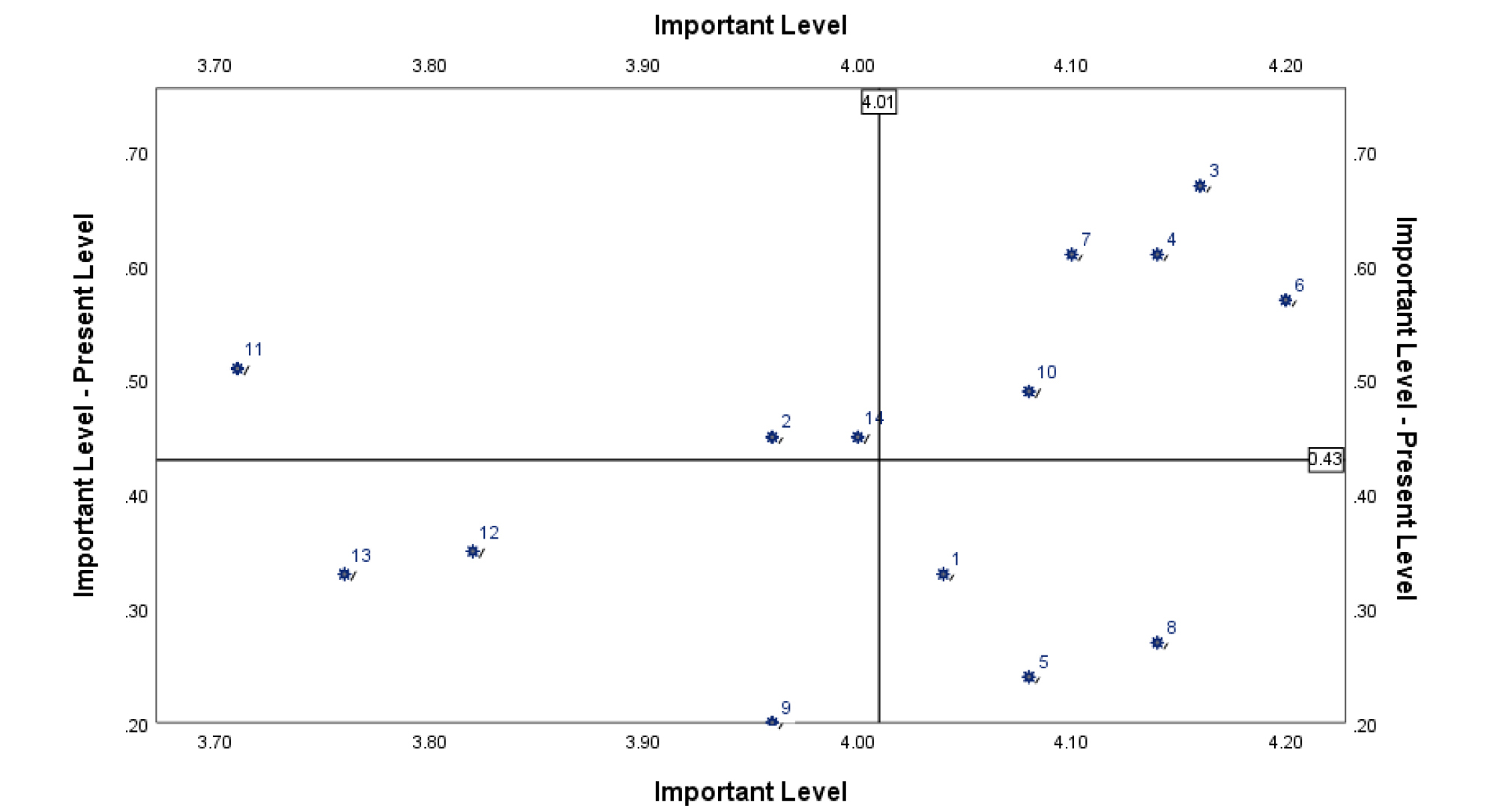
Fig. 3.
The Locus for Focus Model Result of Specialized Knowledge Area
둘째로, 전문기술 역량영역에 대한 Borich 계수와 Locus for Focus Model 분석 결과는 Table 9과 Fig. 4와 같다. 분석결과, 1~6순위의 역량요소들이 1분면 영역(HH)에 포함되어 있어, 집중관리가 필요한 역량요소임을 확인할 수 있었다.
Table 9.
Required Level’ analysis of Job Skills’ component Area
|
Category
|
No.
|
Competency Components
|
Borich Value
|
Priority
|
Locus for Focus
|
|
2. Job Skills
|
2.8
|
Information gathering skills through effective interviews, listening,
observation and review
|
2.61
|
1
|
HH (Q1)
|
|
2.7
|
Audit experience and acquisition/application ability for the organization's
system and management
|
2.50
|
2
|
HH (Q1)
|
|
2.12
|
Skill for verifying corrective actions and results
|
2.43
|
3
|
HH (Q1)
|
|
2.6
|
Skill for the understanding of documents and the preparation of audit reports
|
2.34
|
4
|
HH (Q1)
|
|
2.9
|
Business characteristic analysis skill of corporation
|
2.34
|
5
|
HH (Q1)
|
|
2.10
|
Skill of evaluating objective evidence
|
2.06
|
6
|
HH (Q1)
|
|
2.2
|
Computer utilization skills, such as MS Office and Hangul programs
|
1.68
|
7
|
LL (Q3)
|
|
2.5
|
Skill to plan and organize QMS, EMS, and OH&S audit
|
1.61
|
8
|
HL (Q4)
|
|
2.1
|
Presentation skill
|
1.53
|
9
|
LL (Q3)
|
|
2.3
|
Basic foreign language skill
|
1.40
|
10
|
LL (Q3)
|
|
2.11
|
Skill of appropriate response to complaints from the certificating authority
|
1.08
|
11
|
LL (Q3)
|
|
2.13
|
Consulting skill of corporation management
|
1.07
|
12
|
LL (Q3)
|
|
2.4
|
Time, human and information resource management skills
|
0.88
|
13
|
LL (Q3)
|
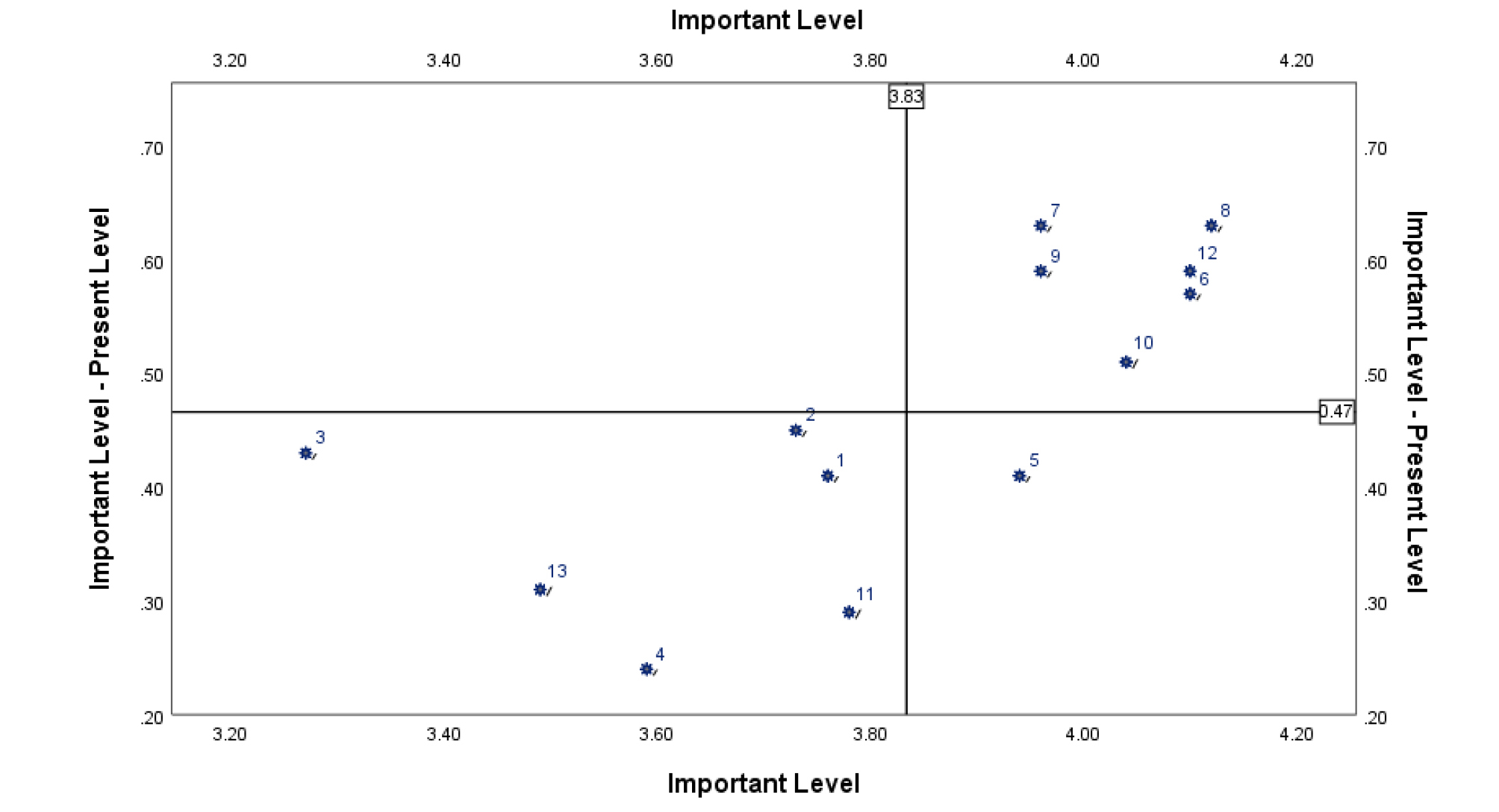
Fig. 4.
The Locus for Focus Model Result of Job Skill Area
셋째로, 개인적 특성 역량영역에 대한 Borich 계수와 Locus for Focus Model 분석 결과는 Table 10과 Fig. 5와 같다. 분석결과, 1~9순위의 역량요소들 중 3.9와 3.15문항을 제외하고 1분면 영역(HH)에 포함되어 있어, 집중관리가 필요한 역량요소임을 확인할 수 있었고, 그 외에 3.9와 3.15문항을 포함하여, 10~13 순위의 역량요소들은 2분면 영역(LH)에 포함되어 있어, 우선순위를 낮추어도 무방한 역량요소임을 확인할 수 있었다.
Table 10.
Required Level’ analysis of Personal characteristics’component Area
|
Category
|
No.
|
Competency Components
|
Borich Value
|
Priority
|
Locus for Focus
|
3. Personal
Characteristics
|
3.20
|
Open mind
|
3.85
|
1
|
HH (Q1)
|
|
3.18
|
Problem-solving
|
3.52
|
2
|
HH (Q1)
|
|
3.19
|
Gathering & managing information
|
3.13
|
3
|
HH (Q1)
|
|
3.6
|
Perceptual objectivity
|
2.76
|
4
|
HH (Q1)
|
|
3.9
|
Flexibility
|
2.76
|
5
|
LH (Q2)
|
|
3.10
|
Technical/professional/managerial experitise
|
2.54
|
6
|
HH (Q1)
|
|
3.15
|
Creative thought
|
2.50
|
7
|
LH (Q2)
|
|
3.2
|
Use of oral presentations
|
2.19
|
8
|
HH (Q1)
|
|
3.8
|
Concern with close relationships
|
2.18
|
9
|
HH (Q1)
|
|
3.21
|
Diplomatic mind
|
2.12
|
10
|
LH (Q2)
|
|
3.11
|
Analytical thought
|
1.93
|
11
|
LH (Q2)
|
|
3.14
|
Critical thought
|
1.91
|
12
|
LH (Q2)
|
|
3.12
|
Conceptual thought
|
1.84
|
13
|
LH (Q2)
|
|
3.13
|
Logical thought
|
1.75
|
14
|
LL (Q3)
|
|
3.22
|
Concentration
|
1.62
|
15
|
LL (Q3)
|
|
3.16
|
Sincerity & responsibility
|
1.53
|
16
|
HL (Q4)
|
|
3.7
|
Stamina and adaptability
|
1.52
|
17
|
LL (Q3)
|
|
3.4
|
Initiative
|
1.51
|
18
|
LL (Q3)
|
|
3.5
|
Self-control
|
1.48
|
19
|
LL (Q3)
|
|
3.17
|
Ethical morality
|
1.47
|
20
|
HL (Q4)
|
|
3.3
|
Achievement orientation
|
0.79
|
21
|
LL (Q3)
|
|
3.1
|
Self-confidence
|
0.34
|
22
|
HL (Q4)
|
|
3.23
|
Appearance & dress
|
-0.40
|
23
|
LL (Q3)
|
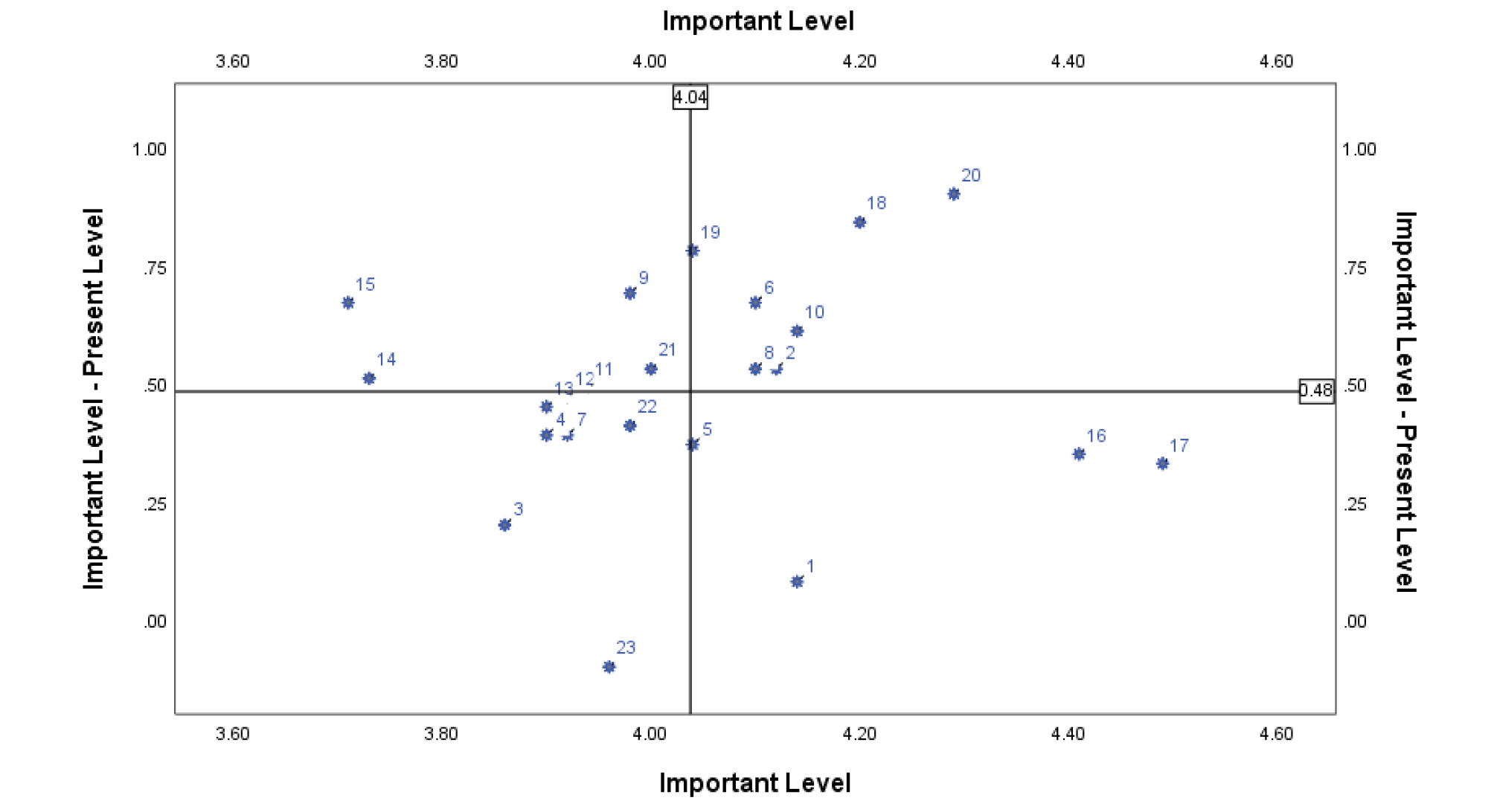
Fig. 5.
The Locus for Focus Model Result of Personal Characteristics Area
넷째로, 전체 역량요소에 대한 Borich 계수와 Locus for Focus Model 분석 결과는 Table 11과 Fig. 6와 같다. 분석결과, 1~21순위의 역량요소들 중 3.9, 3.15와 3.21문항을 제외한 18개의 역량요소들이 1분면 영역(HH)에 포함되어 있어, 집중관리가 필요한 역량요소임을 확인할 수 있었고, 그 외에 3.9, 3.15와 3.21문항을 포함하여, 22~27 순위의 9개의 역량요소들이 2분면 영역(LH)에 포함되어 있어, 우선순위를 낮추어도 무방한 역량요소임을 확인할 수 있었다.
Table 11.
Required Level’ analysis of each competency components
|
No.
|
Competency Components
|
Borich Value
|
Priority
|
Locus for Focus
|
|
3.20
|
Open mind (Considering alternative ideas or perspectives)
|
3.85
|
1
|
HH (Q1)
|
|
3.18
|
Problem-solving
|
3.52
|
2
|
HH (Q1)
|
|
3.19
|
Gathering & managing information
|
3.13
|
3
|
HH (Q1)
|
|
1.3
|
Understanding the audit methods of certification (such as the stage/program for
conducting an audit) and the certification process
|
2.80
|
4
|
HH (Q1)
|
|
3.6
|
Perceptual objectivity
|
2.76
|
5
|
HH (Q1)
|
|
3.9
|
Flexibility
|
2.76
|
6
|
LH (Q2)
|
|
2.8
|
Information gathering skills through effective interviews, listening, observation and
review
|
2.61
|
7
|
HH (Q1)
|
|
1.4
|
Understanding the audit principles & standard of certification
|
2.54
|
8
|
HH (Q1)
|
|
3.10
|
Technical/professional/managerial experitise
|
2.54
|
8
|
HH (Q1)
|
|
1.7
|
Understanding process approach of QMS, EMS, and OH&S
|
2.51
|
10
|
HH (Q1)
|
|
2.7
|
Audit experience and acquisition/application ability for the organization's system and
management
|
2.50
|
11
|
HH (Q1)
|
|
3.15
|
Creative thought
|
2.50
|
12
|
LH (Q2)
|
|
2.12
|
Skill for verifying corrective actions and results
|
2.43
|
13
|
HH (Q1)
|
|
1.6
|
Understanding the audit requirements of QMS, EMS and OH&S
|
2.40
|
14
|
HH (Q1)
|
|
2.6
|
Skill for the understanding of documents and the preparation of audit reports
|
2.34
|
15
|
HH (Q1)
|
|
2.9
|
Business characteristic analysis skill of corporation
|
2.34
|
16
|
HH (Q1)
|
|
3.2
|
Use of oral presentations
|
2.19
|
17
|
HH (Q1)
|
|
3.8
|
Concern with close relationships
|
2.18
|
18
|
HH (Q1)
|
|
3.21
|
Diplomatic mind
|
2.12
|
19
|
LH (Q2)
|
|
2.10
|
Skill of evaluating objective evidence
|
2.06
|
20
|
HH (Q1)
|
|
1.10
|
Identify and understand legal requirements applicable to QMS, EMS and OH&S
|
2.00
|
21
|
HH (Q1)
|
|
3.11
|
Analytical thought
|
1.93
|
22
|
LH (Q2)
|
|
3.14
|
Critical thought
|
1.91
|
23
|
LH (Q2)
|
|
1.11
|
Understanding quality, health & safety environment management tools and applications,
including statistical process management, failure types, and various risk assessments
|
1.90
|
24
|
LH (Q2)
|
|
3.12
|
Conceptual thought
|
1.84
|
25
|
LH (Q2)
|
|
1.14
|
Application and understanding of nonconformities identification methods
|
1.80
|
26
|
LH (Q2)
|
|
1.2
|
Understanding standardization and industrial standardization related laws
|
1.78
|
27
|
LH (Q2)
|
|
3.13
|
Logical thought
|
1.75
|
28
|
LL (Q3)
|
|
2.2
|
Computer utilization skills, such as MS Office and Hangul
|
1.68
|
29
|
LL (Q3)
|
|
3.22
|
Concentration
|
1.62
|
30
|
LL (Q3)
|
|
2.5
|
Skill to plan and organize QMS, EMS, and OH&S audit
|
1.61
|
31
|
HL (Q4)
|
|
2.1
|
Presentation skill
|
1.53
|
32
|
LL (Q3)
|
|
3.16
|
Sincerity & responsibility
|
1.53
|
33
|
HL (Q4)
|
|
3.7
|
Stamina and adaptability
|
1.52
|
34
|
LL (Q3)
|
|
3.4
|
Initiative
|
1.51
|
35
|
LL (Q3)
|
|
3.5
|
Self-control
|
1.48
|
36
|
LL (Q3)
|
|
3.17
|
Ethical Morality
|
1.47
|
37
|
HL (Q4)
|
|
2.3
|
Basic foreign language skill
|
1.40
|
38
|
LL (Q3)
|
|
1.12
|
Understanding the types of risks and opportunities associated with the audit and the
risk-based approach to the audit
|
1.32
|
39
|
LL (Q3)
|
|
1.1
|
Understanding ISO International Standard Establishment procedure and standardization
|
1.32
|
40
|
HL (Q4)
|
|
1.13
|
Responding and understanding changes in industry trends related to QMS, EMS, and
OH&S certification
|
1.23
|
41
|
LL (Q3)
|
|
1.8
|
Understanding the definition, concepts, and guidelines of quality, health and safety
environment management
|
1.10
|
42
|
HL (Q4)
|
|
2.11
|
Skill of appropriate response to complaints from the certificating authority
|
1.08
|
43
|
LL (Q3)
|
|
2.13
|
Consulting skill of corporation management
|
1.07
|
44
|
LL (Q3)
|
|
1.5
|
Understanding the terms of QMS, EMS and OH&S
|
1.00
|
45
|
HL (Q4)
|
|
2.4
|
Time, human and information resource management skills
|
0.88
|
46
|
LL (Q3)
|
|
1.9
|
Understanding the importance and benefits of QMS, EMS and OH&S
|
0.81
|
47
|
LL (Q3)
|
|
3.3
|
Achievement orientation
|
0.79
|
48
|
LL (Q3)
|
|
3.1
|
Self-confidence
|
0.34
|
49
|
HL (Q4)
|
|
3.23
|
Appearance & dress
|
-0.40
|
50
|
LL (Q3)
|
위의 Table 11과 Fig. 6의 분석결과, 전문지식 영역에서는 5개의 최우선순위와 3개의 차기 우선순위, 전문 기술 영역에서는 6개의 최우선순위, 개인적 특성 영역에서는 7개의 최우선순위와 6개의 차기우선순위를 확인할 수 있었다. 그 결과 심사원의 역량강화에 우선적으로 개선이 필요한 18개의 최우선순위군(HH)과 9개의 차기 순위군(LH)은 Table 12와 같이 얻을 수 있었다.
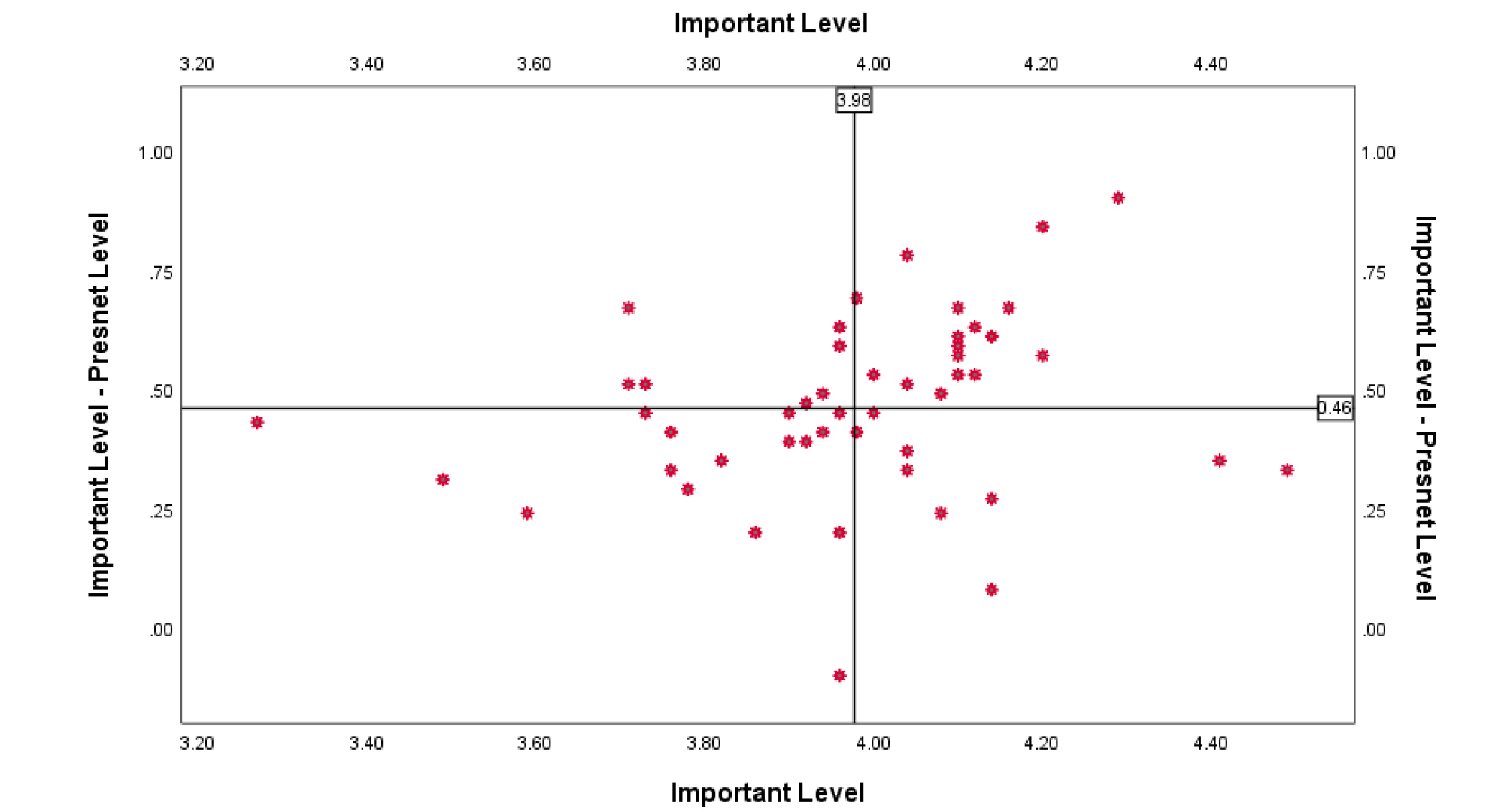
Fig. 6.
The Locus for Focus Model Result of All Areas
Table 12.
Top & Next Priority for each competency components areas
|
Category
|
Priority
|
No.
|
Competency Components
|
Specialized
Knowledge Area
|
Top Priority
|
1
|
Understanding the audit methods of certification (such as the stage/program for c
onducting an audit) and the certification process
|
|
2
|
Understanding the audit principles & standard of certification
|
|
3
|
Understanding process Approach of QMS, EMS, and OH&S
|
|
4
|
Understanding the audit requirements of QMS, EMS and OH&S
|
|
5
|
Identify and understand legal requirements applicable to QMS, EMS and OH&S
|
|
Next Priority
|
1
|
Understanding quality, health & safety environment management tools and applications,
including statistical process management, failure types, and various risk assessments
|
|
2
|
Application and understanding of nonconformities identification methods
|
|
3
|
Understanding standardization and industrial standardization related Laws
|
|
Job Skills Area
|
Top Priority
|
1
|
Information gathering skills through effective interviews, listening, observation and review
|
|
2
|
Audit experience and acquisition/application ability for the organization's system and
management
|
|
3
|
Skill for verifying corrective actions and results
|
|
4
|
Skill for the understanding of documents and the preparation of audit reports
|
|
5
|
Business characteristic analysis skill of corporation
|
|
6
|
Skill of evaluating objective evidence
|
Personal
Characteristics
Area
|
Top Priority
|
1
|
Open mind (Considering alternative ideas or perspectives)
|
|
2
|
Problem-solving
|
|
3
|
Gathering & managing information
|
|
4
|
Perceptual objectivity
|
|
5
|
Technical/professional/managerial expertise
|
|
6
|
Use of oral presentations
|
|
7
|
Concern with close relationships
|
|
Next Priority
|
1
|
Flexibility
|
|
2
|
Creative Thought
|
|
3
|
Diplomatic mind
|
|
4
|
Analytical thought
|
|
5
|
Critical thought
|
|
6
|
Conceptual thought
|
5. 결 론
본 연구의 목적은 ISO 심사원이 필요한 심사역량 요소에 대한 중요도와 보유도의 수준을 파악하여, 심사원이 중요하게 인식하고 있는 역량요소와 현재 보유하고 있는 역량수준을 알아보는 것에 있다. 따라서 본 연구에서는 각 역량요소별로 중요도와 보유도 수준을 설문조사하여, 대응표본 t검정을 통해, 각 역량 요소별 중요도와 보유도에 대한 평균값의 차이가 유의한지 통계적으로 확인하였고, Borich 계수 산출을 통해 각 역량요소별로, 우선순위를 도출하고, Lous for Focus Model를 통해, 각 역량요소를 도식화하여 역량요소들에 대한 최우선순위와 차기 우선순위를 분류하여 다음과 같이 결론을 도출하였다.
첫째, 전체 역량요소와 각 역량영역별 중요도와 보유도에 대해 대응표본 t검정을 통해, 모든 역량영역 이 통계적으로 유의한 차이가 있는 것을 확인하였고, 각 역량영역별로 중요도에 비해 보유도의 평균값 이 낮아 현재 보유하고 있는 역량수준에 대한 개선이 필요한 것으로 나타났다.
둘째, 유의한 역량요소를 동시에 개선하거나 향상시키는 것은 시간적이나 비용적인 측면을 고려했을 때 많은 어려움이 있으므로, 심사역량 요소 중에서 보다 시급하고, 집중관리가 필요한 역량요소의 우선 순 위에 대한 확인이 필요하여, Borich 계수를 통해 도출된 우선순위를 기초로, 전체 역량요소와 각 영역별 역량요소에 대한 최우선 순위와 차기 우선순위를 비교하였고, Locus for Focus Model를 이용하여 분류하였다. 그 결과, 1분면(HH)에 포함되어 우선적으로 집중관리가 필요한 총 18개의 최우선 순위 역량요소와 2분면(LH)에 포함되는 총 9개의 차기 우선순위 역량요소를 얻을 수 있었다.
현대사회에서 품질, 환경, 안전보건, 사업연속성 등 ISO 경영시스템에 대한 인증은 기업의 글로벌 경쟁력 확보 및 이미지 강화 차원 등에서 많은 도움을 주고 있고, ISO 경영시스템의 적합성을 평가받아야 기업 활동을 지속해 나갈 수 있는 기업 경영의 필수적인 요소로 자리를 잡고 있다. 이러한 시점에서 ISO 인증을 필요로 하는 기업을 실제적으로 심사하고 평가하는 심사원의 심사역량이 무엇보다 중요하다고 할 수 있다. 따라서 본 연구를 통해 확인된 ISO 심사원에 대한 18개의 최우선 역량요소들을 체계적으로 반영하여, 심사역량을 향상 시킬 수 있는 교육과정의 개발이나 기존 교육 과정에 대한 수정 및보완 등이 우선적으로 이루어져야 할 필요가 있으며, 향후 9개의 차기 우선역량요소들을 순차적으로 교육과정 등에 반영 할 수 있도록 지속적인 연구와 개발이 필요할 것이다.










